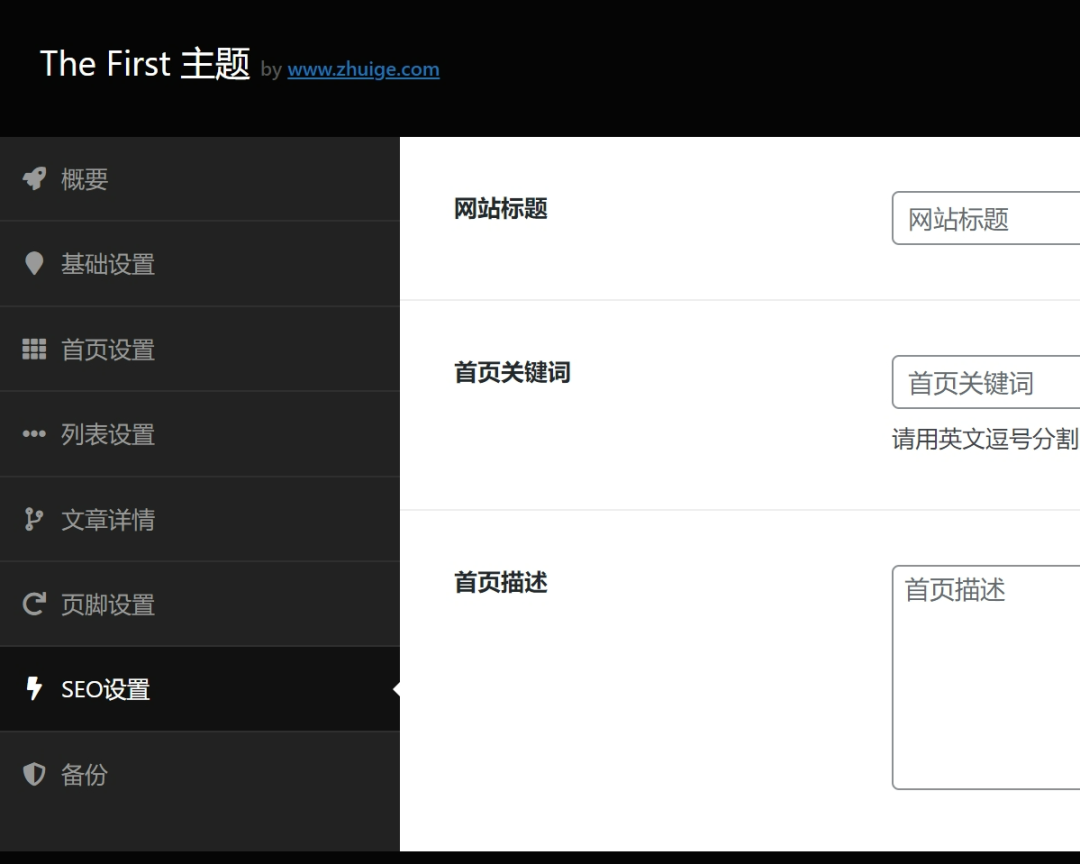hello 啊!又到 WordPress 主题开发教程 的时间了!(本来周三要发的,鬼使神差竟然忘了点“发表”……)
还记得我们在第一篇文章立下的 flag 吗?
教程将以“酱茄Free主题(https://xcx.jiangqie.com)”为例,按此教程一步一步开发,你将得到一份“酱茄Free主题”。
时至今日,我们的 the_first 主题的功能已经开发的差不多了,离完成当日的 flag,只差一丢丢。
还差什么呢?
SEO
在网站兴盛的时候,仅靠 SEO 不知养活了多少人,现在网站势衰,SEO也不像之前那样充斥着各种黑科技了。the_first 主题中对SEO 的处理很简单,就是给每个页面设置好标题,关键词,描述-SEO的基本要求。

上图是后台关于网站首页SEO的设置。在网站首页,读取并设置就可以了。如下代码:
//SEO 标题
function the_first_seo_title()
{
$site_title = jiangqie_option('site_title');
if (is_home() && !empty($site_title)) {
echo $site_title;
} else {
global $page, $paged;
wp_title('-', true, 'right');
// 添加网站标题.
bloginfo('name');
// 如果有必要,在标题上显示一个页面数.
if ($paged >= 2 || $page >= 2) {
echo ' - ' . sprintf('第%s页', max($paged, $page));
}
}
}除了首页,其他页面标题使用 wp_title + 网站名称 + 页码组成。wp_title 函数可以根据不同页面生成合适的标题,只是还不能满足 SEO 的需求。实践中经常在 wp_title 的结果后,再按需拼接必要的内容。
然后,在 header.php 中调用 the_first_seo_title 函数就可以了。
<head>
<title><?php the_first_seo_title(); ?></title>
</head>至于页面的关键词和描述,请看代码:
function the_first_setup_seo()
{
//关键字
add_action('wp_head', 'jiangqie_seo_keywords');
//页面描述
add_action('wp_head', 'jiangqie_seo_description');
}
add_action('after_setup_theme', 'the_first_setup_seo');
//关键字
function the_first_seo_keywords()
{
global $s, $post;
$keywords = '';
if (is_single()) {
if (get_the_tags($post->ID)) {
foreach (get_the_tags($post->ID) as $tag) $keywords .= $tag->name . ', ';
}
foreach (get_the_category($post->ID) as $category) $keywords .= $category->cat_name . ', ';
$keywords = substr_replace($keywords, '', -2);
} elseif (is_home()) {
$keywords = the_first_option('site_keyword');
} elseif (is_tag()) {
$keywords = single_tag_title('', false);
} elseif (is_category()) {
$keywords = single_cat_title('', false);
} elseif (is_search()) {
$keywords = esc_html($s, 1);
} else {
$keywords = trim(wp_title('', false));
}
if ($keywords) {
echo "<meta name=\"keywords\" content=\"$keywords\">\n";
}
}
//描述
function the_first_seo_description()
{
global $s, $post;
$description = '';
$blog_name = get_bloginfo('name');
if (is_singular()) {
if (!empty($post->post_excerpt)) {
$text = $post->post_excerpt;
} else {
$text = $post->post_content;
}
$description = trim(str_replace(array("\r\n", "\r", "\n", " ", " "), " ", str_replace("\"", "'", strip_tags($text))));
if (!($description)) $description = $blog_name . "-" . trim(wp_title('', false));
} elseif (is_home()) {
$description = the_first_option('site_description');
} elseif (is_tag()) {
$description = $blog_name . "'" . single_tag_title('', false) . "'";
} elseif (is_category()) {
$description = trim(strip_tags(category_description()));
} elseif (is_archive()) {
$description = $blog_name . "'" . trim(wp_title('', false)) . "'";
} elseif (is_search()) {
$description = $blog_name . ": '" . esc_html($s, 1) . "' 的搜索結果";
} else {
$description = $blog_name . "'" . trim(wp_title('', false)) . "'";
}
$description = mb_substr($description, 0, 220, 'utf-8');
echo "<meta name=\"description\" content=\"$description\">\n";
}其实,就是一个页面一个页面的去加,自己想怎么加就怎么加,并没有什么特殊的地方。上面代码中的函数,我们大多数都用过了,也就不再啰嗦了。如果想查看一个函数的具体用法,最好的方法就是去官网查询:https://developer.wordpress.org/reference/
这里使用了 WordPress 的钩子去添加,像添加标题那样直接添加在 header.php 文件中的 head 标签里也是可以的。
本来准备聊一下其他 SEO 相关的功能,但是本人对 SEO 的了解,也只是皮毛,恐误人子弟。有一个小小的建议,比如在要实现自动给关键词加链接,自动生成友好的链接…… 等SEO相关功能时,不妨从 WordPress 的钩子入手,只要找到合适的钩子,解决问题自然水到渠成。
关闭“无用”的功能
WordPress 常被人指责“慢”。WordPress 之所以“慢”,就是因为 WordPress 的功能太多。不怪官方的野心太大,只因为用户的需求是无限的,难免忍不住把这样那样的功能塞进 WordPress 里。
我们的 the_first ,只是一个简单的博客主题。WordPress 的基本功能就够用了, 因此,我们需要对 WordPress 进行优化,关闭一些暂时用不到的功能。
清除谷歌字体
function the_first_remove_open_sans_from_wp_core()
{
wp_deregister_style('open-sans');
wp_register_style('open-sans', false);
wp_enqueue_style('open-sans', '');
}
add_action('init', 'the_first_remove_open_sans_from_wp_core');清除 head 中无用的信息
function remove_dns_prefetch($hints, $relation_type)
{
if ('dns-prefetch' === $relation_type) {
return array_diff(wp_dependencies_unique_hosts(), $hints);
}
return $hints;
}
function the_first_remove_laji()
{
remove_action('wp_head', 'wp_generator'); //移除WordPress版本
remove_action('wp_head', 'rsd_link'); //移除离线编辑器开放接口
remove_action('wp_head', 'wlwmanifest_link'); //移除离线编辑器开放接口
remove_action('wp_head', 'index_rel_link'); //去除本页唯一链接信息
remove_action('wp_head', 'feed_links', 2); //移除feed
remove_action('wp_head', 'feed_links_extra', 3); //移除feed
remove_action('wp_head', 'rest_output_link_wp_head', 10); //移除wp-json链
remove_action('wp_head', 'print_emoji_detection_script', 7); //头部的JS代码
remove_action('wp_head', 'wp_print_styles', 8); //emoji载入css
remove_action('wp_head', 'rel_canonical'); //rel=canonical
add_filter('wp_resource_hints', 'remove_dns_prefetch', 10, 2); //头部加载DNS预获取(dns-prefetch)
}
add_action('init', 'the_first_remove_laji');上面的代码仅做示例,实践中可按需使用。经常关闭的 WordPress 功能还有 站点健康检查,图片自动裁剪,自动更新等。
后面 WordPress主题开发教程 就是不定时更新了,用来补充或修改一些 WordPress主题开发的知识点。
能坚持到现在的朋友,还真是有点厉害呢!
最新的代码依旧上传在:
https://gitee.com/zhuige_com/course_jiangqie_theme
https://github.com/zhuige-com/course_jiangqie_theme
再见,朋友们!




暂无评论,抢个沙发...